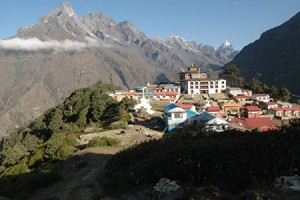
பேனர் படம்: கோங்சியோல் ஜியோங் (1960-2013, குடியரசு (தெற்கு) கொரியா), ஷிம்பாங் என்றும் அழைக்கப்படும் ஒரு ஜெஜு ஷாமன். நாடக நடவடிக்கைகள் மூலம் கலாச்சார இயக்கத்தில் பங்கேற்ற அவர் உண்மையான தைரியத்தை வைத்திருக்கும் ஷாமனாக வாழ்ந்தார் (விழா) புனிதமான நிலப்பரப்புகளுடன் மக்களை இணைப்பதற்காக. (போட்டோ: பாஸ் Verschuuren 2012)
After last year’s preparatory work we are now pleased to introduce a special project page to keep focus on Asian sacred natural sites.
The aim of the work presented under the project is improving recognition and conservation of sacred natural sites in Asia. This is a collaborative effort between the Sacred Natural Sites Initiative, தி வளமார் நெட்வொர்க் ஜப்பான் மற்றும் இந்த ஐயுசிஎன் உலக ஆணையம் மீது பாதுகாக்கப்பட்ட பகுதிகள்-ஜப்பான்.

Tengbuche திபெத்திய Budhist Monestary Kumbu Yul Lha வசித்து ஒரு மலையில் perced உள்ளது. இந்த முன் உள்ளன- கடனாளியென்றும் புத்த பாதுகாப்பான் தெய்வங்கள் புத்த பாதுகாப்பாளராக மீண்டும் தலையெடுக்க. அவர்கள் வன வடிவில் கூட்டாளிகள் வேண்டும், மலை கால்நடைகளை மற்றும் பிற புராண உயிரினங்கள். நேபால். (போட்டோ: கரண்டியால், ஜே)
Because sacred natural sites are key features in Asian landscapes they can be though of as having supported an indigenous Asian philosophy of conservation around community-based protected areas and natural resource conservation.
Therefore the project aims to develop the understanding, recognition and capacity to support sacred natural sites by protected area managers and conservation practitioners in the form of an informal network of experts and practitioners that includes protected area managers and conservation practitioners.
The network took flight at a successful first ஆசிய பூங்கா காங்கிரஸ் in November 2013 were many participated in the special sessions about sacred natural sites.
The network in a way is also an offshoot of the popular ‘IUCN UNESCO Sacred Natural Sites, Guidelines for Protected Area managers’ that had been translated into Korean and Japanese. Realizing that improved conservation tools would be required to help unpack the full potential of sacred natural sites within the context of nature conservation the network is now focusing on producing a series of Asia specific case studies.
Whilst focusing on the translation and application of the IUCN UNESCO Guidelines, most case studies express a broader need to share lessons learned with the wider protected areas community. Have a look here to browse case studies form Asia (set the filter on top of the page to ‘Asia’) and compare them with those in other regions . The World Parks Congress to be held in November 2014 in Sidney Australia will therefore be an important happening for exchange, presentation and further inspiration for participants in the project on Asian sacred natural sites.
என்பதை பாருங்கள் project page, stay tuned for updates and feel free to contact us at info@sacrednaturalsites.org in case you would like to be included on the network email list serve or in case you have other thoughts to share with us.






